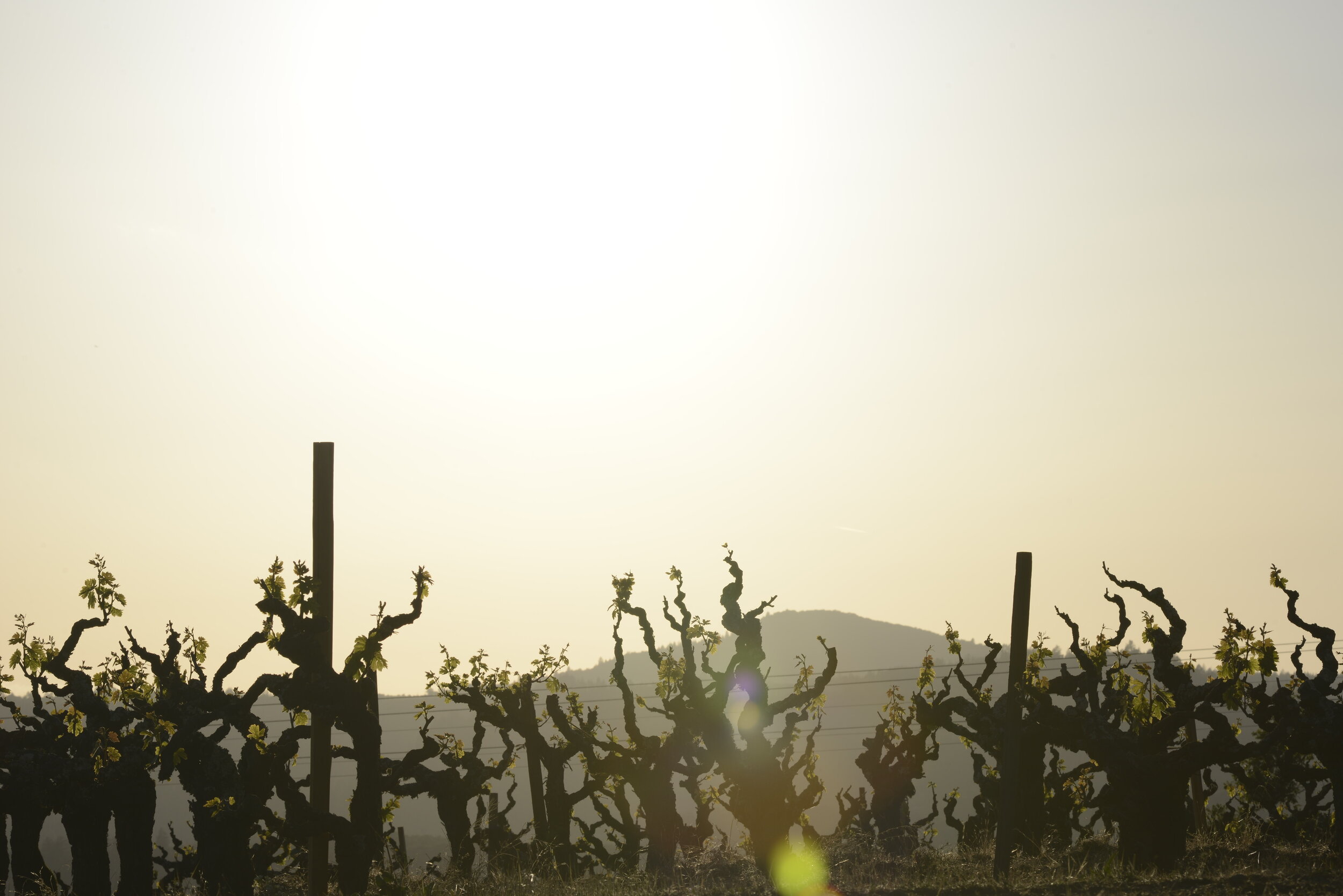“Old Vines” Significance
Enz Vineyard Zinfandel, planted 1895, in Lime Kiln Valley on California’s Central Coast; part of the Old Vines cuvée.
Old Vines, Young Love
We began making the Turley “Old Vines” cuvée twenty years ago, in 2000, and it remains one of the most important wines we make today. The story of this wine is the story of Turley Wine Cellars itself.
After two decades as an emergency room physician, Larry Turley developed a passion for restoration, rejuvenation, and yes, resuscitation. Where others might see decay, decrepitude and neglect, Larry looked beyond, finding instead health, history, and potential. This passion has translated directly into his strong affinity towards old vine vineyards across California, sites that were often neglected in favor of their younger, more vigorous and less troublesome brethren. Some had been abandoned altogether, ripped out for developments or replaced with more lucrative crops. Turley, alongside longtime Vineyard Manager (and now Director of Winemaking) Tegan Passalacqua, is devoted to saving these old vineyards, reinvigorating them through organic farming practices and preserving them in the ground for generations to come.
What Constitutes an “Old Vine?”
There is no technical (read: legal) definition of an “old vine” in the United States, so the common claims on wine labels vary widely. Not content with arbitrary labels—after all, very little is done arbitrarily in emergency medicine—Turley employs fifty years as the minimum vine age to be considered for “Old Vines.” This number was chosen purposefully thanks to the Historic Vineyard Society, of which Tegan is a founding board member. By adopting much of the criteria for consideration as a United States National Historic Landmark, the goal of HVS is to achieve legal protection for these (agri)cultural vineyard sites as historic landmarks. Some of these shared criteria for these sites include:
I. “Sites…that possess exceptional value or quality in illustrating or interpreting the heritage of the United States in history…and culture” and “possess a high degree of integrity of location, design, setting, materials, workmanship, feeling and association.”
II. “Associated with events that have made a significant contribution to, and are identified with, or that outstandingly represent, the broad national patterns of United States history and from which an understanding and appreciation of those patterns may be gained.”
III. “That represent some great idea or ideal of the American people”
IV. “That are composed of integral parts of the environment …[that] collectively compose an entity of exceptional historical or artistic significance, or outstandingly commemorate or illustrate a way of life or culture.”[1]
Indeed, thanks to attentive care in the vineyards and producing wines of elegance, transparency and purity, Turley has proved these ancient vines as the cultural treasures they truly are. After starting with only three vineyards in 1993, Turley now produces wine from over 50 vineyards, 31 of which are old vine sites, and 18 over 100 years old. To our knowledge, today Turley works with more old vine vineyards than any other winery in the world. None of this would be possible without the “Old Vines” wine, home to fruit sourced from these many salvaged old-vine sites across California. If it weren’t for this particular cuvée, many of these vineyards would have been lost, along with over a century of our cultural heritage.
[1] Legal Information Institute, 36 CFR § 65.4 - National Historic Landmark criteria
Zinfandel vines planted in the 1930s in the Sonoma Valley fog.
80 year old vines still going strong, basking in the California sun.
Hayne Zinfandel vine, planted 1902, St. Helena, Napa Valley.
Bechthold Vineyard Cinsault vine, planted 1885 on its own roots in Lodi.
Why are old vines superior?
In addition to their cultural significance, old vines produce a naturally more complex, balanced, and sustainable wine. Young vines tend to be vigorous and high yielding for a short period of time (16-20 years) before most wineries rip them up and replant, to keep yields at a maximum; think of the brief but intense career of an NFL player. Young modern vineyards are also almost always irrigated, which keeps the yields high and the root systems shallow, but can (in our opinion) dilute the quality and integrity of the final wine.
An old vine, on the other hand, naturally regulates its yields, focusing all of the vine’s energy into a more finite—and ultimately more concentrated—final wine. Furthermore, these vines are dry-farmed, meaning they survive only on the natural rainfall patterns and water tables of their respective micro-climates. Finally, they are more deeply rooted in the soils, reaching down over 40 feet into the earth in some cases. For these reasons, we believe the final wines produced by truly old vines are the truest representations of their respective terroirs. Plus, they just taste good!
Varietal Composition of “Old Vines”
The vast majority of old vine vineyards in California are field blends, for two fundamental reasons:
I. DNA testing did not begin in earnest until 1993, nearly 100 years after many of these vineyards were planted.
II. Early winemakers did not have large estates to experiment with planting various varieties in different locations, with different soils or exposures to make blends, so they often did their “winemaking” in the vineyards themselves. Primarily this consisted of planting the majority of their site to one main variety (i.e. Zinfandel) then planting a few rows of various other grapes to use as a “spice rack” of sorts. These made up very small percentages of the final blend, serving primarily to “season” the main variety.
Final little fun fact: we firmly believe that all the best of our single-vineyard old vine Zinfandels come from field blend sites. Take the Hayne Zinfandel, planted 1902-03 in Napa Valley; it is and always has been the crown jewel of Turley’s wines. After Zinfandel, the 2nd most widely planted grape variety in that vineyard is…Trousseau Noir!
100 year old ungrafted vines in Mendocino County.
Ungrafted Zinfandel vine planted 1915 in Lodi







